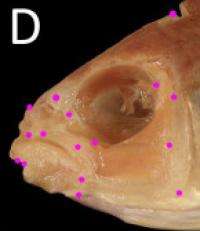Lopsided fish show that symmetry is only skin deep

Putting function before form, members of the Perissodinus genus of fish have developed a hugely lopsided jaw that provides a distinct feeding advantage. Research published in the open access journal BMC Biology describes how these scale-eating fish, called cichlids, develop mouths directed either to the left or the right - enabling them to feed on the opposite side of their prey.
A research team from Syracuse University, led by Thomas Stewart and R. Craig Albertson, studied the facial evolution of cichlids from Lake Tanganyika in eastern Africa, where they feed on the scales of larger lake-dwellers. According to Stewart, "While most animals have bilateral symmetry and some show a radial symmetry, asymmetries are actually relatively common in nature. For example, humans can be either left handed or right handed, and one side of the brain is structured differently to the other. Often, both the trait and whether it is placed on the left or right are genetically determined, and the population as a whole tends to show the same characteristic. For example, most people have their heart positioned slightly to the left".
The research team found that there is a genetic locus that determines whether a cichlid will be a 'lefty' or a 'righty'. However, they add that these developmental divergences are more complicated than originally thought. "Some scale-eaters start off with balanced mouths, and others do not. So, what happens as these symmetrical fish get older: do they develop asymmetries due to lateralized foraging behaviors? Do they develop asymmetries due to lateralized growth? Do they die because they are not effective hunters?" debates researcher Craig Albertson. He continues, "All three are possible, but we do not have data to support any one of these scenarios. It would seem, however, that in this group an innate, genetically-determined left/right difference has been accentuated to enable a bizarre predatory life style."
More information: Evolution of a unique predatory feeding apparatus: functional anatomy, development and a genetic locus for jaw laterality in Lake Tanganyika scale-eating cichlids, Thomas A Stewart and R. Craig Albertson, BMC Biology (in press)
Provided by BioMed Central

















